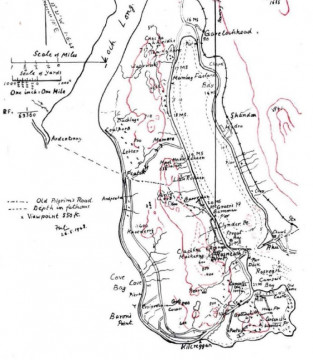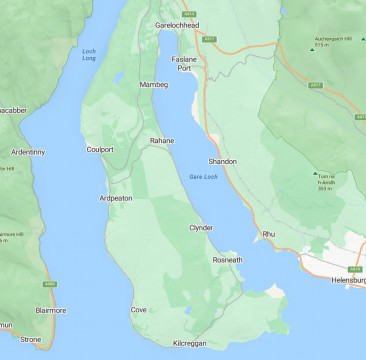About Our Community and a Brief History
In the administrative area of Argyll and Bute, Scotland, lies the small village of Rosneath. The village sits on the ‘Rosneath Peninsula‘, bordered on the west by Loch Long, on the east by the Gareloch, and on the south by the Firth of Clyde. The Rosneath Peninsula is completely surrounded by water except for a slender land bridge at Garelochhead, leading to the perspective in former times of being an Island, as described as “The Isle of Rosneath” by notables such as Sir Walter Scott in his novel The Heart of Midlothian.
Rosneath is about 3 kilometres from the nearest significant village of Kilcreggan, which is sited on the southern end of the peninsula on the shores of the Firth of Clyde. There are also a number of significant villages bordering Rosneath, such as Clynder, Rahane, Mambeg and Garelochhead to the north and Cove and Kilcreggan to the Southwest. The Gare Loch, narrows at Rosneath to around 600 meters at a place known colloquially as ‘Rhu Narrows’, after the village of Rhu (formerly Row) on the eastern shore of the loch.
The Rosneath peninsula was formerly in the County of Dunbarton (Dumbartonshire), until local government reorganisation moved it into the Argyll and Bute administrative area in 1996. The nearest town with a wide range of services is Helensburgh 25 kilometres away by road. There is a railway station in Garelochhead. Also a passenger only ferry linking the Peninsula from Kilcreggan to Gourock.
Our Place Names
There are identifiable processes that occur over time to place names, which alter their pronunciation in such a way that the original meanings are often lost. These apply to both the names of settlements and their natural features. The process is just as true for Rosneath as any other part of Scotland.
The name of Clynder is apparently derived from Clandearg, Clyndairg or Claon Dearg meaning ‘Red Slope’ or Cluain Dearg ‘Reddish Meadow’. While Gareloch is Gaelic for ‘Short Loch’. The meaning of the place name for Rosneath is not so clear, ‘ros’ means point or promontory but ‘neath’ is interpreted differently by Gaelic scholars. The name of Rosneath may have its roots far earlier, when it was settled in the 6th Century by St. Modan who was a travelling missionary, Abbot and possibly the son of an Irish chieftain, who founded a church at Ros Neimhidh.
There have been several attempts to determine the origins of the name which is clearly derived from Gaelic. One account suggests Rossnachoich, meaning ‘Virgin’s Headland’. Another suggests that it may come from Ross-neoth, or ‘unwooded headland’ or ‘Bare Promontory’. The definitive answer provided by William J. Watson, LLD. (1865–1948), Professor of Celtic languages and toponymist is probably the best considered. He stated that the anglicised version of Ros-neimhidh is said to mean ‘Promontory of the Sanctuary’. The Nemet (neimhidh) refers to Church lands or sanctuary which formerly extended to the east side of Gareloch, where Rhu is today, which was formerly part of the parish of Rosneath. Again, the Gaelic Neimhidh is thought to be derived from the Gaulish Celtic word Nemeton which means a place of ritual meetings and which was adopted into Christianity as meaning ‘land belonging to the church’.
There are also a number of other place names in our community whose spelling and meanings have been changed or have been lost over time. – Peaton, Peatoun, or Peatburn in Gaelic is Alt-na-mone. Barbour is derived from the Gaelic, Bran-na-bruach, meaning above the bank. Mamore, from Mam, a knoll, more, is great. Mambeg, the little knoll. Rahane , Rachane or Rahian, had a number of meanings, such as a ferny place, an enclosed space, a place of signal or fire, or even John’s promontory. Stroul, Strouel, from strulag, meaning a spout. A reference to the Well that exists today at that point.
Whatever the Gaelic origin of the name, Rosneath was historically spelt in the Anglicised form as ‘Roseneath’ (or Roʃeneath as described in the First Statistical Account of Scotland 1791 – 1799, notice the old fashioned long S – printed as ʃ ). A more visible example of that spelling is Roseneath Street in Greenock which overlooks the peninsula has existed since around 1900. In addition, there are many examples of the place name being used by former residents who emigrated to other parts of the UK, British colonies and Empire, of taking with them a familiar name reminding them of home. They used that familiarity in naming streets or towns throughout the world. These may be found today in in wide locations such as, Edinburgh, Manchester, Canada, New Zealand, Australia, Gloster Louisiana and Richmond Virginia, to name a few.
Early History
No history of this community can ignore the earliest references to the efforts of the early Christian missionary St Modan. For centuries the community has discussed those early references to St Modan and incorporated them into the social fabric of community life. Some doubt exists as to Modan’s correct name, and when exactly he had resided in these parts. Even the scholarly efforts of the Rev. William Meiklejohn discuss the, “paucity of reliable information about Modan that historians are at variance even about the century that he lived”. Either way, sometime from the sixth century, St Modan, and other early Christian missionaries resided in these beautiful parts. Meiklejohn tells us that such activity was challenging as, “the country was covered with forests, through whose dense, untamed undergrowth the traveller had often to cut and hack his weary way and whose foliage was so thick in places that even in summer the sunshine scarce could penetrate.” He expands, advising that, “hardly a winter passed without man and domestic beast being reduced to near starvation”. Times were extremely hard for those early inhabitants of Rosneath, not least of these being the tragedies of those taking the advantage of the post Roman influence such as the Picts, the Gaels of Dál Riata, the Britons of Alt Clut and the Norse–Gaels.
We do know however, that by the thirteenth century lives where marginally better with Alexander III granting Rosneath to the jurisdiction of the Abbot of Paisley, along with the saltpans and the extensive of Salmon stocks that resided in the Gareloch of the time.
By Medieval times the area was heavily fortified with castles at Rosneath Faslane, Shandon, and Ardencaple, all of which are now long gone. Rosneath’s own castle was described in the 15th century Scottish epic poem, known as ‘The Wallace’, composed by Scots poet and balladeer Blind Harry. Harry’s poem tells the story of how William Wallace around 1297, during the First War of Scottish Independence, sacked the town of Dumbarton then laid waste the castle at Rosneath and during this deed he leapt from a cliff to escape the English, swimming across the mouth of the Gareloch to Cairndhu Point. The Duke of Argyll‘s chamberlain, Lorne Campbell, reported the marking of that site in preparation for the New Statistical Account of 1845 as a “precipice a short way north from Parkhead, over which the Patriot Wallace is said to have leaped; His Horse was killed but he escaped unhurt.” This location may be added to one of the several Wallace leaps (Loup), with others at Greenock and Dumfries.
In 1489, Colin Campbell, the first Earl of Argyll, received the grant of ‘the lands of Rosneath’ from the Scottish crown and for some five centuries thereafter they remained in Campbell hands until 1941. The second Earl of Argyll, Archibald Campbell, fell at Flodden field on 9th September 1513, along with most of the Scottish nobility including his brother-in-law, Matthew Stewart, the second Earl of Lennox. In 1558, Archibald Campbell, Lord Lorne, only son and heir of Colin Campbell, third Earl of Argyll, was conferred by Mary, Queen of Scots, the lands of Rosneath with its lands, castle, mills, etcetera. In 1573 the Campbell properties of Rosneath were increased through the acquisition of Little Ros, Meikleross, and Portkill, and conferred by James VI.
Throughout the seventeenth century, the reigning monarchs conferred the Campbells of Argyll, the lands of Rosneath. In 1644 the eighth Earl and the first Marquis of Argyll, also an Archibald Campbell, disagreed with the religious policies of King Charles I. The following Scottish civil war seen Argyll’s forces up against an army that was composed mainly of highland Clans and a contingent from Ireland, led by James Graham, Marquis of Montrose. Argyll was surprised by Montrose at Inverlochy and thereafter Argyll witnessed the slaughter of 1,500 Campbell troops. To the distress of the local inhabitants, after the battle of Inverlochy, elements of Montrose’s force invaded and sacked Argyll, including Inveraray. During those tragic times, the concerned inhabitants of Rosneath, to where Argyll had fled, were summoned by the ringing of the church bell (Burgerhuis bell), to learn that the dreaded royalist Highland and Irish forces were in the Dunoon area, just a short distance across Loch Long. Rosneath’s inhabitants of the day were very alarmed at the possibility of an attack, but fortunately this never occurred. However, following the final defeat of Montrose’s men by the Covenanters at Philliphaugh in 1645, the afore mentioned Archibald, the 8th Earl, supported the restoration of Charles II.
At the Coronation of Charles at Scone in 1651, Archibald placed the crown of Scotland on Charles II’s head (the last crowning of a King at Scone). With great ceremony, he uttered the words that would make him king, stating –
“... and now, yer Majesty, yer subjects shall approach.”
Some ten years later Archibald again lost royal favour and was then executed in Edinburgh by the ‘Maiden’ in 1661, to which his son, Archibald, the 9th Earl also succumbed to in 1685, when leading a rebellion against James II (James VII).
That village bell, which hung originally in the old Parish church, was cast in 1610 by Ian Burgerhuis (Jan Burgerhuys), a renowned Master Founder of the Middelburg foundry, Zeeland, Netherlands. As described above, the Bell had rung out over the Gareloch, noting the highpoints, alarms and celebrations for over 300 years. Again during the later Jacobite Rising of 1715 the Church Bell was ordered rung by the then parish minister, Neill Campbell. In response he gathered “fifty stout parishioners together and marched at their head to join the John, 2nd Duke of Argyll on the side of the government”. They met the Duke near Stirling, who with astonishment remarked that the men of Rosneath were more suitable for handling the plough and the oar, than the sword or spear. The Duke commended their patriotism and retained some for service on the boats, supporting the army on shore. Neill Campbell (1678-1761) was a Gaelic speaker due to the parish requiring a Gaelic minister. Even as late as 1720, there were still 26 families within this community who understood no English. Like many of Rosneath’s sons and clergy, Neill Campbell went on to be the distinguished Principal of Glasgow University in 1728.
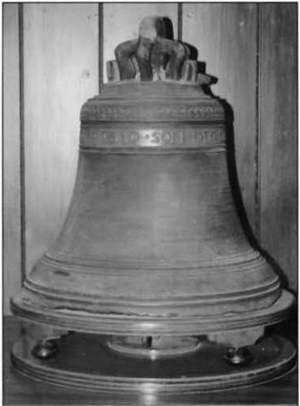
As Scottish political affairs became more settled during the 18th and 19th centuries, the Argyll family regained power as Dukes of Argyll, initially through the leadership of Archibald Campbell, 1st Duke & 10th Earl of Argyll. So after a number of generations of poor outcomes for the family and their communities, the Argyll family started to have greater influence over local and national matters, with the family producing many leading soldiers and statesmen supporting the British establishment. In 1871 John Campbell the Marquis of Lorne MP, heir to the Duke of Argyll, married HRH the Princess Louise, fourth daughter of Queen Victoria. Rosneath became the Princess’ favourite Scottish home and on visits to the Rosneath estate, she and her husband were duly welcomed at the village pier by the principal tenants, the magistrates of Kilcreggan and Cove and the resident gentry of the peninsula.
Rosneath Castle
Since the settling of man after the Ice age retreated from the Clyde, the Castle point has a defensive viewpoint, with a strategic perspective up and down the river. It may therefore be assumed that there has been some significant construction in that place since before the sack of Dumbarton by Amlaíb Conung’s Norse–Gaels (Vikings) from Dublin in 870. Although Rosneath Castle’s original construction date is not known, it is thought to have been sometime in the 12th century. A reasonable historic assumption indicates it predated William Wallace’s (1270-1305) activities in these parts, suggesting something far earlier as stated in the Early History section above. A significant construction standing near Castle Bay can be dated to the 15th century. Records indicate that in 1489 Rosneath lands were confiscated from John Stewart, the first Earl of Lennox who was found to have engaged in treasonable practice. Although his family was later pardoned for the offence, the lands of Rosneath were still awarded to his cousin Colin Campbell, first Earl of Argyll.
Around 1630, Archibald Campbell the 1st Marquis of Argyll developed Rosneath as a secondary residence to Inveraray Castle. The main access to the Castle was from the shore below where visitors, including the Argyll family, travelling from Inveraray to their Rosneath lands would disembark from their galley at the mouth of the Gareloch and enter the Castle by means of an easily defended tunnel leading underground into the castle basement.
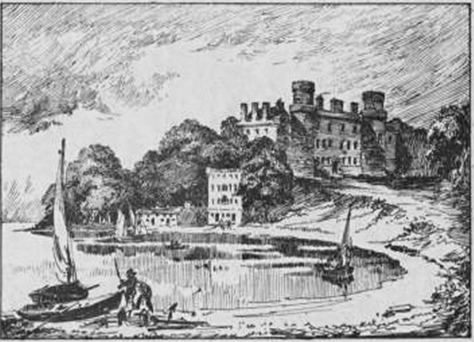
The old Rosneath Castle
In 1802, Rosneath Castle was destroyed by fire and the Castle was then replaced by Rosneath House, the new neo-classical mansion designed by Joseph Bonomi. This was constructed a short distance away from the original site between 1803 and 1805. The new house required many servants, it was difficult and costly to heat and in 1897, Princess Louise engaged Sir Edward Lutyens to design a new annexe to the old Ferry Inn which was conveniently close to Rosneath pier and the paddle steamer service to the railway at Helensburgh.
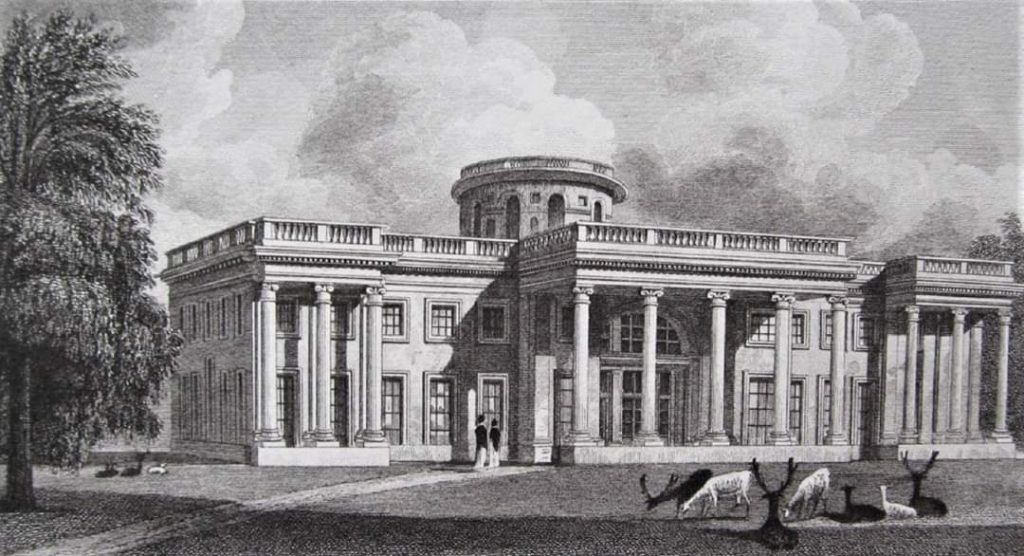
Joseph Bonomi – Neoclassical designed Rosneath castle (Now styled Rosneath House)
Recent History
As seen in the aerial photograph below, from 1941 to 1945 Rosneath and the Castle was home to an important naval base (United States Naval Base two). From this well-sheltered natural harbour of the Gare Loch, the Americans and Royal Navy used Rosneath Castle as a base of operations.
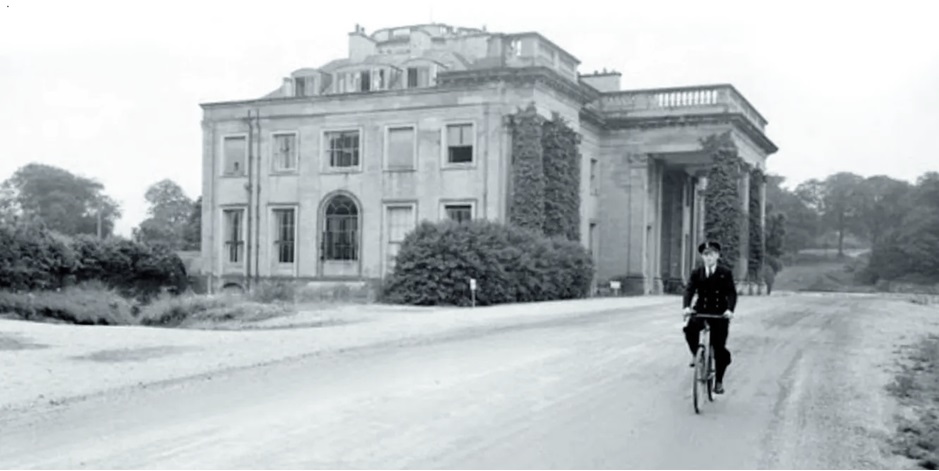
Naval Officer on Bicycle
Here Rosneath played a significant role that led to the invasions of Italy and then France, with Churchill, Eisenhower and Montgomery holding talks at Rosneath concerning the D-Day offensive. Sadly, after the Second World War Bonomi’s Ducal Palace with Ionic columns, grand portico, front balustrade and circular tower were abandoned and the remains demolished by 1961.
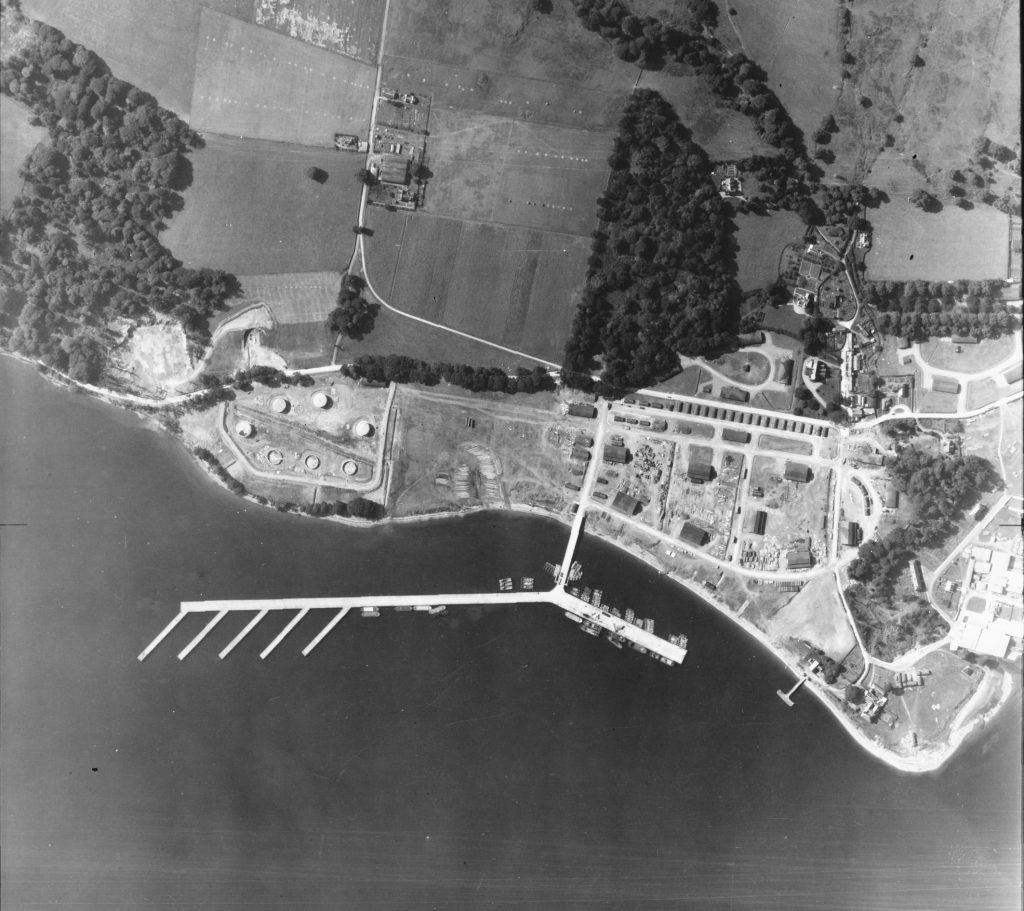
Aerial Photograph of Rosneath Village and Facilities around the Jetties
Later Edits
Aspects of local history and heritage that people are proud of, that will be included in later edits – include:
• Maritime history of boat building and fishing as a mainstay of the past economy
• The Clachan Conservation Area a number of buildings listed for their architectural
significance
• The Rosneath churchyard location of the only known grave in Scotland of an African
slave – Robert Story
• The Burgerhuis bell

